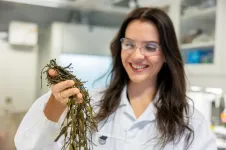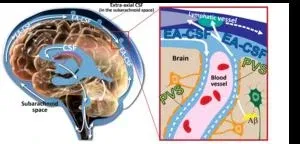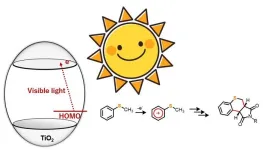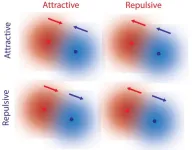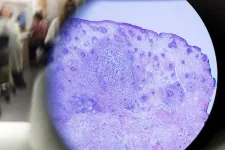(Press-News.org) Norway’s exports products derived from from tangle kelp (Laminoria hyperborea) and knotted kelp (Ascophyllum nodosu) to the tune of more than NOK 1 billion a year. The industry mainly extracts alginate from kelp, which is used in over 600 different products as diverse as paint, soft serve ice cream, sauces, bandages, nappies, acid reflux medicine and material for encapsulating cells and medicine. However, the market is far from saturated.
“Alginate is becoming a scarce commodity on the global market. There are great opportunities here if we could cultivate more kelp that yielded alginate of good enough quality,” says Finn Aachmann, a professor at the Norwegian University of Science and Technology (NTNU) who heads the Norwegian Seaweed Biorefinery Platform.
Today, wild tangle kelp is harvested from the large kelp forests that grow naturally along the Norwegian coast, but there are limits on the amount that can be harvested. We need new resources if we want to expand the Norwegian kelp market. Cultivated kelp is a good alternative.
The kelp industry is expanding
Tangle kelp grows so slowly that its cultivation is simply not worthwhile. Over the past decade, the cultivation of more fast-growing kelp species has developed into a thriving industry.
“This year, between 600 and 700 tonnes of sugar kelp and winged kelp were grown on ropes in the sea,” says Katharina Nøkling-Eide, a PhD candidate at the Norwegian Seaweed Biorefinery Platform.
However, alginate comes in many forms, and cultivated sugar kelp and winged kelp don't produce alginate of the same high quality as wild tangle kelp does. Cultivated kelp is currently so expensive that it is only used in food production.
“This is a shame because production could be scaled up significantly through the development of new, high-quality products from cultivated kelp. Alginate could be one of these products,” says Nøkling-Eide.
Fortunately, new findings may help us be able to extract better alginate from the cultivated kelp. This research has been undertaken under the auspices of the Norwegian Seaweed Biorefinery Platform and Industrial Biotechnology (SFI-IB), a Norwegian Centre for Research-based Innovation.
Cultivated species can be just as good
“We have developed a new method for efficiently upgrading alginates from cultivated kelp,” says Aachmann.
The solution involves enzymes called epimerases. Enzymes promote chemical reactions between different substances without the enzymes themselves being used up.
“These epimerases convert mannuronic acid into guluronic acid in the alginate chain, so that the alginates are more similar to the tangle kelp alginates than they originally were, making them more industrially viable,” says the professor.
Researchers isolated these enzymes for the first time from an alginate-producing bacterium in Trondheim more than 50 years ago, so this research goes back a long way. However, it is not until now that the seaweed industry has embraced the solution.
Required additional time and resources – until now
“Over the past 30 years, several studies have shown that we can use these epimerases to upgrade alginates from seaweed and kelp, but the kelp industry has not yet started using them,” says Aachmann.
Upgrading alginates after they have been extracted and purified from the kelp biomass takes additional time and resources. So, the industry hasn’t really been tempted to use the method.
However, what if you could add these enzymes at the same time as extracting the alginate from kelp – so you wouldn’t have to spend extra time and money doing it afterwards?
This is exactly what researchers from SINTEF and the Norwegian University of Science and Technology (NTNU) have managed to do. They carried out the study in a joint laboratory for kelp in Trondheim.
Improves alginate during extraction
“We have shown that it is possible to epimerise alginates from sugar kelp, winged kelp and the lamina fraction, which is the leaf -like section at the top of the stalk, during the actual alginate extraction process,” says Nøkling-Eide.
In other words, the alginate is refined at the same time as it is being extracted from kelp. This saves time and is cost-effective.
“In large-scale trials, we managed to get an alginate from cultivated sugar kelp that was just as good as the industry would normally get from wild-harvested tangle kelp,” says Nøkling-Eide.
The researchers also believe that it is possible to achieve similar results with cultivated winged kelp.
Good news for kelp farmers
“The findings of this study are encouraging. In the future, Norwegian alginate may also come from cultivated kelp,” says Aachmann.
Kelp farmers are also dependent on established kelp markets, because they need someone to sell all their kelp to. This will help kelp farmers further increase their production.
“The alginate market is an established market that can help secure the livelihoods of kelp farmers in the future. In that sense, it is a win–win situation,” says Nøkling-Eide.
New products from kelp are important for SFI Industrial Biotechnology. The centre's partners are SINTEF, NTNU, NMBU and NORCE and 16 industrial companies.
Reference: Katharina Nøkling-Eide, Finn Lillelund Aachmann, Anne Tøndervik, Øystein Arlov, Håvard Sletta, In-process epimerisation of alginates from Saccharina latissima, Alaria esculenta and Laminaria hyperborean, Carbohydrate Polymers. https://doi.org/10.1016/j.carbpol.2023.121557
END
Cultivated kelp can now be as good as wild kelp
You may not know much about alginates, but you have probably used them or eaten them. Cultivating kelp can help expand the market for this useful product
2024-01-02
ELSE PRESS RELEASES FROM THIS DATE:
Researchers identify new coding mechanism that transfers information from perception to memory
2024-01-02
Our memories are rich in detail: we can vividly recall the color of our home, the layout of our kitchen, or the front of our favorite café. How the brain encodes this information has long puzzled neuroscientists.
In a new Dartmouth-led study, researchers identified a neural coding mechanism that allows the transfer of information back and forth between perceptual regions to memory areas of the brain. The results are published in Nature Neuroscience.
Prior to this work, the classic understanding of brain organization was that perceptual regions of the brain represent the world "as it is," with the ...
A novel switch to turn genes on/off on cue, a promising step toward safer gene therapy
2024-01-02
Just like a doctor adjusts the dose of a medication to the patient’s needs, the expression of therapeutic genes, those modified in a person to treat or cure a disease via gene therapy, also needs to be maintained within a therapeutic window. Staying within the therapeutic window is important as too much of the protein could be toxic, and too little could result in a small or no therapeutic effect.
Although the principle of therapeutic window has been known for a long time, there has been no strategy to implement it safely, limiting the potential applications of gene therapy in the clinic. ...
Food insecurity among low-income adults dropped nearly 5% during pandemic-era SNAP expansion
2024-01-01
Embargoed for release until 5:00 p.m. ET on Monday 1 January 2024
Annals of Internal Medicine Tip Sheet
@Annalsofim
Below please find summaries of new articles that will be published in the next issue of Annals of Internal Medicine. The summaries are not intended to substitute for the full articles as a source of information. This information is under strict embargo and by taking it into possession, media representatives are committing to the terms of the embargo not only ...
A tidy cell seems to keep aging at bay
2024-01-01
Osaka, Japan – Just as healthy organs are vital to our well-being, healthy organelles are vital to the proper functioning of the cell. These subcellular structures carry out specific jobs within the cell, for example, mitochondria power the cell and lysosomes keep the cell tidy.
Although damage to these two organelles has been linked to aging, cellular senescence, and many diseases, the regulation and maintenance of these organelles has remained poorly understood. Now, researchers at Osaka University have identified a protein, HKDC1, that plays a key role in maintaining these two organelles, thereby acting to prevent ...
Chemical synthesis using titanium dioxide: An eco-friendly and innovative approach
2024-01-01
Heterocyclic compounds are organic molecules with a ring structure comprising at least two or more elements. In most cases, these rings are composed of carbon atoms along with one or more other elements such as nitrogen, oxygen, or sulfur. They are highly sought-after as raw materials in the chemical and pharmaceutical industry, owing to their versatility and excellent physiological activities. While several methods are available for synthesizing these compounds, most of them involve high temperature and pressure conditions, or the use of precious ...
Want to quit smoking in 2024? Cytisine can help … if you live in the right country
2024-01-01
A new study published in Addiction has found that cytisine, a low-cost, generic stop-smoking aid that has been used in eastern Europe since the 1960s, increases the chances of successful smoking cessation by more than two-fold compared with placebo and may be more effective than nicotine replacement therapy. It has a benign safety profile, with no evidence of serious safety concerns. Sounds perfect for your New Year resolution, doesn’t it? But there’s a catch: Cytisine is not licensed or marketed in most countries outside of central and eastern Europe, ...
Sodium’s high-pressure transformation can tell us about the interiors of stars, planets
2023-12-29
Travel deep enough below Earth’s surface or inside the center of the Sun, and matter changes on an atomic level.
The mounting pressure within stars and planets can cause metals to become nonconducting insulators. Sodium has been shown to transform from a shiny, gray-colored metal into a transparent, glass-like insulator when squeezed hard enough.
Now, a University at Buffalo-led study has revealed the chemical bonding behind this particular high-pressure phenomenon.
While it’s been theorized that high pressure essentially squeezes sodium’s electrons out into the spaces between atoms, researchers’ quantum chemical ...
Endocrine Society applauds Ohio governor veto of state ban on gender-affirming care for minors
2023-12-29
WASHINGTON—The Endocrine Society, the world’s oldest and largest professional medical society devoted to the study and treatment of hormone-related conditions, applauds Governor Mike Dewine’s veto of a proposed Ohio law that would have banned gender-affirming care for minors. The bill he vetoed contradicts mainstream medical practice and scientific evidence and would have taken medical decision-making out of the hands of families and their physicians and instead relied upon government officials.
More ...
Molecules exhibit non-reciprocal interactions without external forces, new study finds
2023-12-29
Researchers from the University of Maine and Penn State discovered that molecules experience non-reciprocal interactions without external forces.
Fundamental forces such as gravity and electromagnetism are reciprocal, where two objects are attracted to each other or are repelled by each other. In our everyday experience, however, interactions don’t seem to follow this reciprocal law. For example, a predator is attracted to prey, but the prey tends to flee from the predator. Such non-reciprocal interactions are essential for complex behavior associated with living organisms. ...
MSK research highlights, December 29, 2023
2023-12-29
New research from Memorial Sloan Kettering Cancer Center (MSK) developed CAR T cells that target two acute myeloid leukemia-specific antigens; shed new light on a genetic element called LINE-1, opening the door to new treatments; identified a key regulator of blood stem cell fate; and found an immunotherapy technique using antibodies that target CD47 shows promise in mice.
CAR T Cells that target two antigens treat AML with minimal toxicity
Acute myeloid leukemia (AML) has so far resisted treatment with chimeric ...
LAST 30 PRESS RELEASES:
The “broker” family helps tidy up the cell
Ecology: Mummified cheetahs discovery gives hope for species’ Arabic reintroduction
Researchers survey the ADHD coaching boom
Air pollution and cardiac remodeling and function in patients with breast cancer
Risk of suicide in patients with traumatic injuries
Post–intensive care syndrome
The lifesaving potential of opioid abatement funds
The Frontiers of Knowledge Award goes to Allan MacDonald and Pablo Jarillo-Herrero for their discovery of the “magic angle” enabling science to transform and control the behavior of new materials
Discovery reveals how keto diet can prevent seizures when drugs fail
JMIR Publications and Sikt announce pilot flat-fee unlimited open access partnership
Finding new cell markers to track the most aggressive breast cancer in blood
A new, cleaner way to make this common fertilizer
Fire-safe all-solid-state batteries move closer to commercialization
Disinfecting drinking water produces potentially toxic byproducts — new AI model is helping to identify them
Unplanned cesarean deliveries linked to higher risk of acute psychological stress after childbirth
Healthy aging 2026: fresh pork in plant-forward diets supported strength and brain-health biomarkers in older adults
Scientists identify pre-cancerous states in seemingly normal aging tissues
Itaconate modifications: mechanisms and applications
Potential tumor-suppressing gene identified in pancreatic cancer
Winners of the 2026 Hill Prizes announced
Autonomous AI agents developed to detect early signs of cognitive decline
Study finds ocean impacts nearly double economic cost of climate change
Increased deciduous tree dominance reduces wildfire carbon losses in boreal forests
Researchers discover how a respiratory bacterium obtains essential lipids from the human body and targets fat-rich tissues
Locust swarms destroy crops. Scientists found a way to stop that
More resources and collaboration needed to support prevention and treatment of obesity
Two types of underconfidence linked to anxiety and gender
Insects are victims too: Global study shows impacts of invasive alien species on populations
Pioneering natural, degradable polymer capsules
Forestry is becoming digital and automated
[Press-News.org] Cultivated kelp can now be as good as wild kelpYou may not know much about alginates, but you have probably used them or eaten them. Cultivating kelp can help expand the market for this useful product
